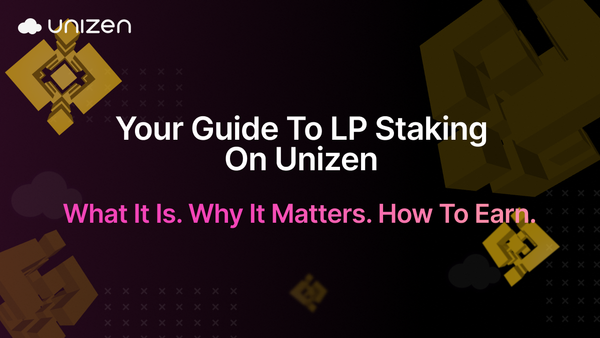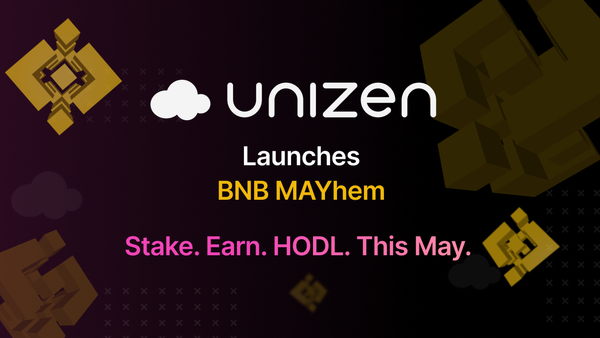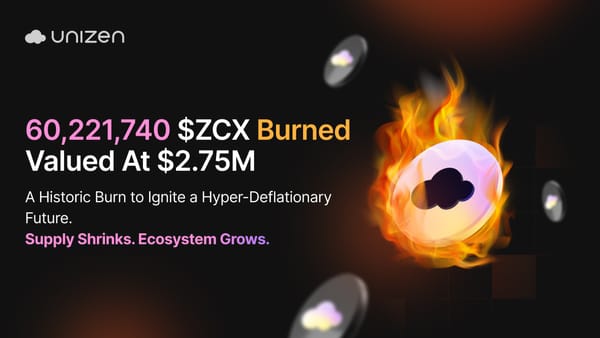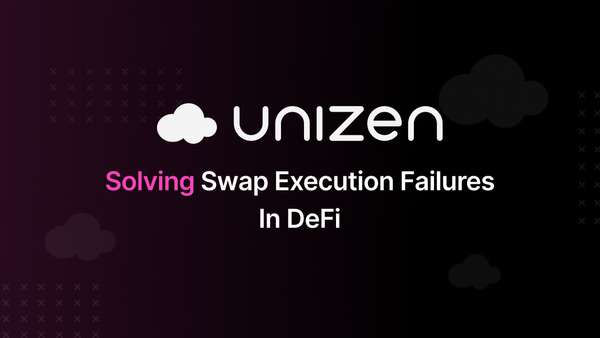How Do Bitcoin Miners Work?
How Do Bitcoin Miners Work? Understand the basic mechanisms of Bitcoin mining, such as the mining process, mining rewards, and other requirements.
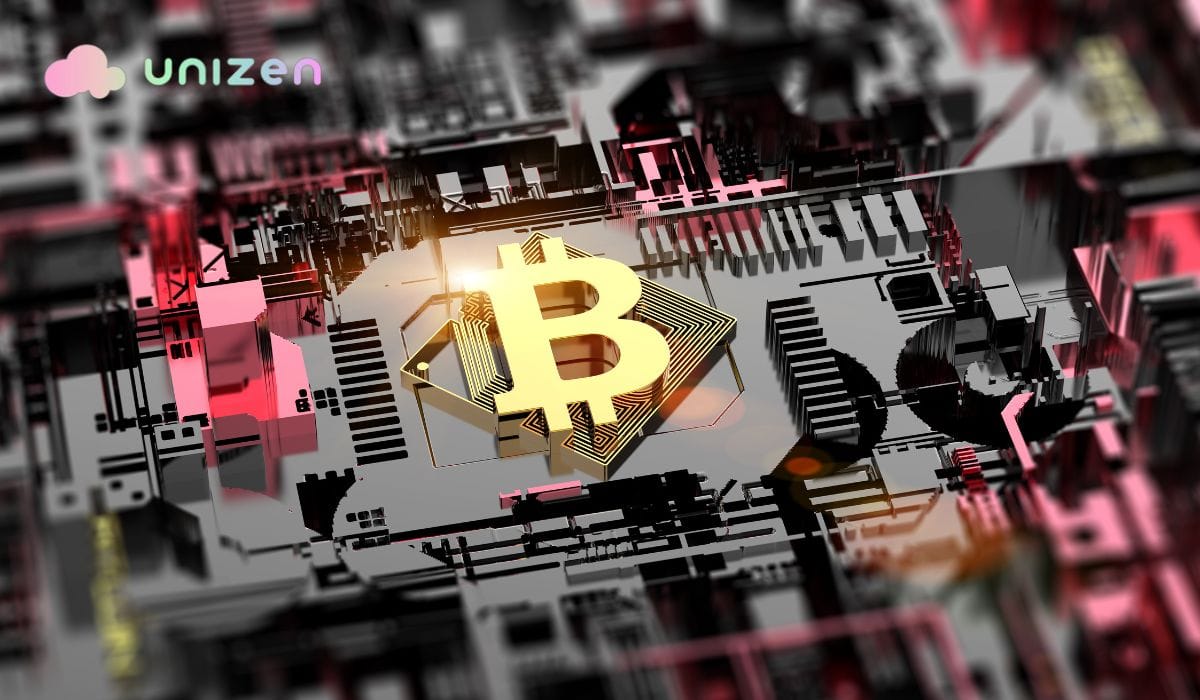
Bitcoin is an electronic currency that is not backed or regulated by any country or central bank. As a decentralized form of currency, Bitcoin relies on a peer-to-peer network like Unizen that approves transactions through mining. Mining is an essential element to the functionality and security of the blockchain network that underpins Bitcoin. Bitcoin miners use powerful computer hardware to repeatedly perform complex mathematical calculations. They do this to be the first to find a valid proof-of-work solution, which allows them to add a new block of transactions to the blockchain and earn the associated block reward. In this article, we will explore everything that has to do with Bitcoin mining and miners.
What is Bitcoin Mining?
Bitcoin mining is simply the process by which new transactions are checked and included in the public record, known as the blockchain. To understand how do Bitcoin miners work, it’s important to know that people or companies try to be the first to solve complicated mathematical computations and create new blocks of transactions. The miner is paid for their computational work in bitcoins.
In contrast to traditional methods of extracting gold, Bitcoin mining does not require expensive equipment and significant investment. It can be performed using special application-specific integrated circuits (ASIC) chips. ASIC miners are connected to the Blockchain and work in parallel to validate transactions by solving the cryptographic problem. Authenticating each transaction involves solving other complicated computational problems, and creates a new block that has a digital signature or proof that the miner worked.
Miners are essential since they perform proof of work validation to secure the network and check for double spending of Bitcoin. This makes the decentralized digital currency credible without an intermediary institution. Miners also add new bitcoins into circulation in fixed intervals as the network's algorithms dictate. Thus, the miners are incentivized to ensure the Blockchain is reliable and secure.
The Bitcoin Mining Process
Bitcoin mining is a multi-step process that proceeds in the following order:
Transaction Verification
This involves sending Bitcoin from one wallet to another, creating a transaction that will circulate on the peer-to-peer Bitcoin network. An unconfirmed transaction is broadcasted from the full nodes that build the network and can be relayed to the next full node until it has been received by most of the total nodes.
Miners then collect these broadcast transactions and prioritize processing and verifying them before including them in a candidate block. This includes verifying the transaction's validity by validating the digital signature and ensuring the sending wallet has sufficient funds.
For the system to remain secure, double spending of coins must be eliminated. If a sender could spend the same coins twice, it could undermine the integrity of the Blockchain. Miners are essential in checking the transaction history on the Blockchain to validate that the sender has not already spent the coins referenced in the broadcast transaction. Preventing double-spending in this manner maintains the soundness of the Bitcoin system.
Creating a Block
Creating a block involves the collection of pending transactions from the network's memory pool (mempool) by miners. The mempool (memory pool) refers to the unconfirmed pool of transactions gathered by each node after being broadcast across the network but before inclusion into a validated block.
Miners will select valid transactions from their mempool based on optimization criteria like transaction fees and priority to maximize reward. Transactions with sufficiently high fees will be prioritized for inclusion. This selection process forms the content of a candidate block.
To control the scalability and propagation speed of blocks across the network, a fixed limit is imposed on the size of each Block. The limit is set at 1 megabyte to restrict the number of transactions within a single block. This prevents blocks from becoming excessively large and delaying the confirmation of other transactions.
Solving the Proof-of-Work Puzzle
The PoW algorithm uses cryptographic hash functions to introduce artificial scarcity and incentivize miners to allocate computing resources toward processing transactions and securing the network. This consensus mechanism allows anyone to independently verify the validity of the blockchain.
Miners add an arbitrary number called a "nonce" to the block header, which contains a hash of the previous Block, a timestamp, and other transaction data. Multiple hashes are computed using this nonce and block data until a valid hash satisfying the network's difficulty is produced.
To maintain stable average block times, Bitcoin adjusts the complexity of the proof-of-work algorithm by raising or lowering the difficulty target. Roughly every 2,016 blocks or two weeks, the difficulty is recalculated based on the actual time of previous blocks found. So, on average, one new block continues being produced every 10 minutes, regardless of mining hash rate fluctuations. This ensures steady and predictable issuance of new bitcoins.
Adding the Block to the Blockchain
Once a miner finds a valid proof-of-work, they broadcast the completed block, including all verified transactions, to all nodes on the Bitcoin network. Upon receiving the new block, other miners employing significant hashing power immediately work to validate it by calculating the proof-of-work for that block. This ensures authenticity.
If verified as authentic, the block is added to the end of the decentralized blockchain– a permanent online public ledger containing all validated blocks– by linking it to the hash of the preceding block. This append-only property and computationally secure linking of blocks makes the blockchain resistant to modification, maintaining security.
Mining Rewards
Miners are currently awarded 3.125 newly minted bitcoins for each block added to the blockchain, plus any transaction fees from transactions included in that block. This provides the core incentive to secure the network.
About every four years, a Bitcoin halving event occurs, during which the block reward is programmed to halve, decreasing the inflation rate. In April 2024, the last halving reduced the reward from 6.25 to 3.125 BTC. This cyclically decreasing supply impacts miner profitability and network security over time.
At the current block reward and average transaction fees, miners receive roughly $215,000 for mining each block. With projected halvings in 2028 and 2032, the price would need to rise considerably to maintain that revenue level. By 2140, the final block reward halving will reach 0, and transaction fees are expected to sufficiently incentivize miners to continue securing the network after that.
Mining rewards are a key factor in determining Bitcoin's long-term viability, and its perfect understanding is essential to know how do Bitcoin miners work. Its supply schedule and security model were carefully designed around a fixed and diminishing annual issuance rate to maintain a predictable monetary policy without compromising decentralization.
Mining Hardware and Software
Hardware Requirements
When Bitcoin first launched, mining was easily done on regular CPUs. As the network grew and mining became difficult, specialized hardware provided significantly higher hash rates. GPUs offered better parallelization than CPUs, but ASICs surpassed both by being single-purpose chips optimized specifically for Bitcoin's SHA-256 algorithm.
The arms race among miners to obtain the most efficient SHA-256 computing power means ASICs are now required to remain competitive. However, their development costs can run into the millions. Combined with high electricity needs, this barriers smaller operators and centralizes mining in locations with cheap power. A single ASIC machine now costs thousands of dollars and consumes over 1,500 watts, prioritizing large-scale professional mining operations.
As the rewards decrease over time, higher upfront and operational costs will squeeze out all but the most efficient industrial mining players. This trend leads some to argue that mining centralizes the network over the long run, though it remains decentralized among leading operators worldwide.
Software Requirements
Popular mining software choices include CGMiner, EasyMiner, BFGMiner, and Nanopool's Miner. These programs allow users to set up and monitor mining machines and access mining pools.
After downloading the appropriate mining software, it needs to be configured with the address of a mining pool. The pool address information can be obtained on the pool's getting started page. Basic settings include the mining protocol (e.g., stratum+tcp) port number, wallet Bitcoin address, and machine hashing boards/ASIC details. The software then tests the mining hardware connectivity.
Rewards are typically automatically deposited to the associated wallet address when shares of valid proof-of-work are found. Payout thresholds, fees, and other policies vary by pool. Remote access and overclocking tools within the software allow for tweaking machine performance. Logs aid in monitoring hash rates, system status/temperature, and shares submitted/accepted.
Proper software, driver, and firewall configuration are essential for pool connection stability and maximum hashing efficiency. Miners can join pools solo or use optimized multi-GPU setup scripts.
Mining Pools
Due to competitive conditions, most Bitcoin mining now occurs via specialized large-scale facilities and mining pools. Mining pools allow individual miners to combine their hashing power so they can earn rewards more consistently instead of relying solely on luck. Miners work together on a shared task and split rewards proportional to the shares completed. Some miners may use platforms where they can access multiple pools to diversify their mining activities across different blockchain networks.
Pools track the hash rates of its members to determine how many "shares" have been completed. When a block is found, the rewards are split proportionately to each miner's contribution of shares for a given round. This mitigates earnings volatility compared to an all-or-nothing result from solo mining.
Advantages and Disadvantages of Joining a Mining Pool
Advantages
- Small and frequent rewards.
- There are more opportunities to earn money
- Less hardware is needed
Disadvantages
- Potential loss of earnings if pool servers crash.
- Fees charged by some pools also affect earnings.
Economic Considerations
Economic factors to look at, which may impact profitability and the choice to be a miner, include the following:
- Electricity Costs: This relates to the cost of power to run the mining equipment, an ongoing expenditure. Areas where the cost of electricity from renewable energy sources is low are likely to experience good mining profitability.
- Hardware Costs and Efficiency: Concerning the direct costs involved in mining, a very significant expense is hardware costs, such as ASIC miners. Miners with higher capacity and efficiency are always costly, though they have higher production capacity.
- Hash Rate: This is the amount of computation done by a miner, typically measured in hashes per second (H/s), which indicates how fast a miner can attempt to solve blocks and get rewards. Indeed, more powerful hardware that is capable of delivering a better hash rate will bring in the returns at a faster pace.
- Difficulty in Adjustments: With the increase in the number of miners, mining becomes more difficult, so mining blocks takes only a limited amount of time. Higher difficulty means that every hash computation is less likely to solve a block. This evens out the rewards over a longer period while raising electricity costs for a given amount of hashing power.
- The issue of volatility: Cryptographic currency prices are unpredictable and fluctuating. Mining is at its most profitable stage when the value of coins is high. Losses are incurred when the prices are reduced, and the only way this cost can be offset is when there are efficiencies in the hardware or electricity used in computing.
Break-Even Analysis and Cost-Benefit Considerations
To do an economic break-even analysis of the cost and benefits of mining, consider the following:
Estimate your cost as follows
- Research the upfront purchase price of ASIC miners or GPU rigs and other startup costs like PSUs, motherboards, cabling, etc.
- Amortize the hardware costs over the expected lifespan, usually 1-2 years.
- Look up your local electricity rate per kWh.
- Determine the power consumption of your hardware in watts.
- Multiply watts by hours mined per day by cost per kWh to get daily electricity costs.
Estimate the revenue
- Use a calculator to estimate the hash rate of your hardware.
- Input the expected network difficulty increase percentages monthly.
- Calculate the coins you can mine on average each month based on hash rate and coin block reward structure.
- Assign a value to the coins you will mine based on the current price or your forecasted price within the payback period, around 6-12 months.
- Add up the monthly coin value to get the estimated total monthly revenue.
Compare Costs to Revenue
- Add up monthly hardware amortization costs and electricity costs for expenses.
- Subtract the monthly expenses from the monthly revenue.
- Determine the number of months it will take for this monthly profit to exceed total hardware costs (break-even point).
Factor in risks
- Consider difficulty increases, price volatility, hardware failures in your analysis, and break-even estimates.
- The higher the risks, the longer the break-even period should be for the operation to be profitable.
This analysis helps determine if mining a particular coin is cost-effective and profitable. This is based on the short and medium terms based on your cost of production versus the expected revenue from selling the coins. It should be re-evaluated regularly as variables change.
Environmental Impact
In the last few years, the topic of energy consumption has become increasingly contentious regarding how do Bitcoin miners work. Due to Bitcoin's increasing value and demand, the intensive use of electricity for processing and mining equipment has become a significant issue. It is believed that Bitcoin mining accounts for approximately 127 TWh of electric power consumption per year. To give that some context, that electricity could light up Chile or the Netherlands for a full year.
The energy source for this electricity generation has raised questionable environmental impact. Most mining occurs where electricity is relatively cheap, such as in parts of China that still rely on coal power. This means that much energy used to power the Bitcoin network is sourced from dirty sources such as coal. Efforts have been made to calculate Bitcoin's total amount of CO2 emissions, wherein the mining of Bitcoin alone emits more than 65 million tons of carbon dioxide annually.
Criticisms:
- Currently, most bitcoin mining depends on the energy created by fossil fuels such as coal, making it vital for reducing carbon emissions. Some conservative estimates put its carbon footprint at over 60 million tons annually
- When more computational power is needed to solve the equation that forms a block in Bitcoin, it consumes more electricity exponentially without any change. It is used at the same rate as a medium-sized country today when efficiency is valued.
- Some critics argue that Bitcoin offers no utility for consuming such an amount of energy and that it should be compared to other industries that require equivalent energy.
Potential Solutions:
- Converting mining operations into solar energy systems, wind energy, and hydroelectric may also go a long way in making mining as environmentally friendly as possible.
- Miners could look for opportunities where energy sources are already overproduced or where wasted energy production currently exists, as in the case of mining with natural gas flare capture that would otherwise be burnt.
- Increased efficiency through more innovative chips used in these mining rigs over time would ensure power demands rose at a slower rate.
- These applications also raise the possibility of using waste heat from other processes like data mining.
- A carbon tariff or emissions scheme might encourage miners to seek cleaner energy sources.
- Positive reinvestment into new renewable energy deployment reduces carbon from current mining operations.
The shift doesn't occur quickly because of fixed physical infrastructure. However, dedication to cleaner generation sources and utilizing efficiencies is a strategy to mitigate Bitcoin's environmental footprint since it is massive and continues to expand rapidly. An environmental change might help the food delivery platform become more sustainable and socially accepted in the long run.
Security and Decentralization
Mining plays a crucial role in the validation process and in adding new transactions to the blockchain safely and securely. To complete the mining process, miners try their best to guess the result of the great cryptography algorithm and gain the right to include the next block of the transactions in the chain. Thus, they are guaranteed to be genuine and executed in the right order for a particular sequence.
By designating tremendous computational resources to solve new blocks, it is impossible to alter transaction records or double-spend coins because a hacker needs greater than 50% of the entire hashing capacity. Miners also spend resources to secure the blockchain history, which proves incredibly beneficial when it comes to hacker attempts.
A crucial aspect of Bitcoin Security and Decentralization is the 51% attack. It involves a miner or a mining pool that gains more hash rate than 50% of the hash rate of the particular blockchain that is being targeted. They can also occasionally launch invalid blocks and overturn transactions that already reached consensus, making transactions or links to the chain a bad bet or forging the chain to undo or suppress changes.
If successful, it neglects the fundamental tenets of decentralization and immutability as adopted by the user base. A slight majority, which can be even 51%, may become possible to attack by forking the chain or delaying the confirmations of the transactions. Continuity of hash rate boundaries is essential to ensuring the safety of the entire system.
The Bitcoin blockchain system is highly robust because, according to the concept of the cloud, there is a broad distribution of hashing power among thousands of mining hives worldwide, using all kinds of hardware and mining in different geographical regions. It also means that special interests or a central authority cannot take over the updates as their exclusive province.
Self-sufficiency also slows down collusion or coordination attacks because it is impossible to compel separate entities to agree on fraudulent acts without exposure. Distribution addresses the issue of having so-called 'single points of failure that could potentially be shut down either through technical difficulties or directions to do so.
Geopolitical diversification also helps reduce any government's ability to influence a large portion of miners or disrupt hash rate supplies through political means. Maintaining long-term decentralization is crucial for Bitcoin to remain secure without censorship risk.
Future of Bitcoin Mining
Through advances in chip designs and cooling technologies, mining hardware is becoming more powerful, efficient, and specialized. Due to economies of scale, larger industrial-scale mining operations have emerged. If left unchecked, this could concentrate hash power in the long term.
Bitcoin's anonymity and decentralized nature of cryptocurrencies may face government restrictions over time. Regulations could target mining directly or indirectly through electricity/environment policies. International cooperation would be needed for rules to meaningfully impact the geographically diffuse mining network.
Also, adaptation to renewable energy sources like solar, wind, and hydro will be necessary for mining's environmental sustainability as energy demands grow tremendously. To decrease energy use through decentralization tradeoffs, new consensus mechanisms that use less computing power, like proof-of-stake, are being explored.
Conclusion
Bitcoin mining plays a critical role in validating transactions and maintaining the security of the blockchain network. Distributed consensus through competitive mining incentivizes global participation that decentralizes control. However, challenges regarding how do Bitcoin miners work, such as energy use, geographic concentration, and potential regulations, must be addressed going forward. Adapting mining practices towards sustainability and decentralization preservation through diversification will determine Bitcoin's long-term viability. Overall, mining remains essential for upholding core qualities like immutability. With continual improvement, the mining sector reinforces Bitcoin's role as a censorship-resistant currency secure without centralized governance.
Frequently Asked Questions
Who Can Be a Bitcoin Miner?
Here are some key points about who can be Bitcoin miners and the role of mining pools:
- Individual Miners: Anyone can theoretically mine; however, the increasing difficulty often means it's not profitable unless specialized equipment is used with meager electricity costs.
- Professional Miners: Large-scale professional mining operations have emerged, using custom-built ASIC rigs and warehouses with cheap power. These tend to dominate hashing power.
- Mining Pools: Most miners now participate in pools to combine hashing power and split rewards based on shares of work contributed.
Why Is Mining Necessary for Bitcoin?
Mining is necessary to validate transactions and add them securely to the blockchain. It incentivizes nodes to participate and ensures no single entity controls the network.
What Equipment Do I Need To Start Mining Bitcoin?
You will need an ASIC miner, motherboard, power supply, cooling fans, and mining software. A high-end rig can cost thousands of dollars.
How Do I Calculate the Potential Earnings from Bitcoin Mining?
You need to consider your hash rate, power costs, mining pool fees, and the network difficulty that affects rewards over time. Profits are not guaranteed.
What Is the Environmental Impact of Bitcoin Mining?
Critics argue the large energy usage from rigs adds costs and e-waste. Supporters counter that mining incentivizes green energy development and secures a global financial network.
What Are the Risks Associated with Bitcoin Mining?
Risks include high startup/maintenance costs, rapidly changing mining difficulty reducing yields, dependence on pool uptime, regulatory uncertainty, and equipment obsolescence.
